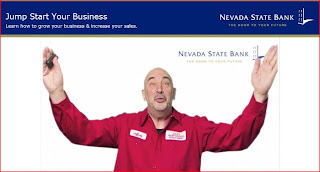 Nevada State Bank
Nevada State Bank made a smart move. They tapped business and sales guru
Jeffrey Gitomer to conduct an online webinar for small business clients and prospects. In the approximately 1-hour webcast, the animated Gitomer flailed his arms as he presented point after point of solid sales strategy for the rough upcoming year. Gitomer, who has authored a number of sales-oriented books, is a draw for any marketing event, but that’s not what’s unique about Nevada State’s strategy. What’s unique is the bank’s awareness of stepping up to the plate and offering businesses a hand. . . or in this case, the knowledge to work their way out of recession.
This isn’t the first foray, or even the last, into online “education” for Nevada State Bank. They have been doing it for the past year. Their 30-45 minute webinars complete with additional 15-minute live Q&A opportunities have been monthly events for the Nevada-based bank. Past archived webinars include a
Stephen Covey presentation, insights from publisher
Darren Hardy of Success Magazine, an SBA lending event and economic forecasts.
Tom Sweet, Vice President of Marketing at Nevada State Bank, introduced the webinar concept to his bank’s marketing department. He previously used the same format at a Los Angeles bank. In a phone interview, Sweet said that they’d “originally started the webinars to build awareness for who we are and add credibility to some of the services that we offer and provide value-added to clients and prospects.
“The results have been huge,” he explained. “Different subjects draw different size audiences. They generate a lot of goodwill and a lot of good word-of-mouth feedback and interest. The smallest audience was approx. 500 to up to thousands.” The Gitomer presentation proved more popular. Sweet credits the webinars with increased business for the bank.
The marketing veep remarks that he hasn’t seen a consistent, on-going webinar program in other banks’marketing plans.
Promoting to small business.Gitomer wrote about his preparation for the Feb. 24th webinar in his popular Sales Caffeine email newsletter saying he spent more time preparing for this event than his regular live seminars. Gitomer, who has his own large following, promoted the event on his blog, Facebook, Twitter, and LinkedIn pages. From there it went viral. Nevada State Bank’s marketing department added email, offline and online advertising including biz journal ads, bellybands on newspapers, direct mail and online banners to the promotion mix for their webinar series. A
microsite on the bank’s website also promoted the free webinar along with event registration.

From a “budget stand point, it’s [the webinar series]not huge, noted Sweet of his marketing budget for his 57 bank offices. “ It’s an important component , but it’s not everything.” Nevada State Bank has used outside technology resources to pull off the events; although the more savvy the bank marketing staff has become, the more they are able to handle themselves.
Stepping up as a small business leader.I’ve been a long-time proponent of bank marketing departments looking beyond traditional advertising to reach their audiences. It would be a huge facelift for more of the banking industry to step up and change the image of banking. . . from self-serving to customer-service. Small business is especially in need of a helping hand. Perhaps the conclusion of the Gitomer webinar says it best. He endorses the bank’s efforts at the end of his online presentation, stating that Nevada State Bank “gets it” and that they’re “the only bank in the country who understands the real state of the economy.” From Gitomer’s loyal fan-base, this definitely is a seal of approval.
What this means for Community Banking:No matter what your bank’s marketing budget, you can recreate your own online version of this same educational strategy. Don’t be intimidated by the Gitomer and Covey names on this webinar’s roster. Tap into your community and business leaders as expert presenters and create 2 to 5 minute low-cost, no frills video and post it to your website, deliver it via email to customers and make it available to small business prospects. Be pro-active and set your community bank up as a small business promoter worthy of their loyalty.
Related articles in Bank Marketing:Energize your small business clientele & you’ll earn entrepreneurs’ loyalty.



